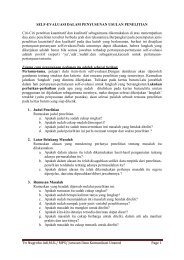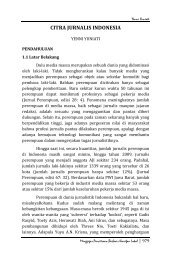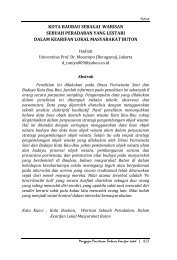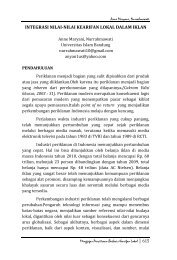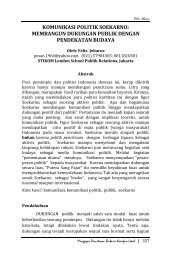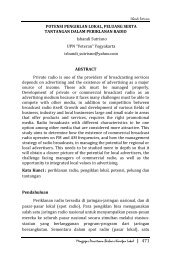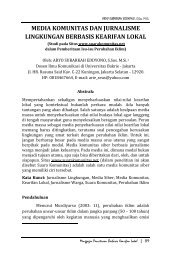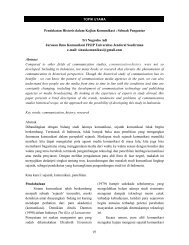New Vocabularies in Film Semiotics
New Vocabularies in Film Semiotics
New Vocabularies in Film Semiotics
You also want an ePaper? Increase the reach of your titles
YUMPU automatically turns print PDFs into web optimized ePapers that Google loves.
PSYCHOANALYTIC THEORY 145<br />
THE CINEMATIC APPARATUS<br />
Because the psychoanalytic constitution of the film-spectator also suggested<br />
ways of understand<strong>in</strong>g the social impact of the c<strong>in</strong>ema as an <strong>in</strong>stitution,<br />
Metz first made his claim for the psychoanalytic approach <strong>in</strong> terms of the<br />
c<strong>in</strong>ema’s <strong>in</strong>stitutional form. In “The Imag<strong>in</strong>ary Signifier” he speaks of the<br />
“dual k<strong>in</strong>ship” between the psychic life of the spectator and the f<strong>in</strong>ancial<br />
or <strong>in</strong>dustrial mechanisms of the c<strong>in</strong>ema <strong>in</strong> order to show how the reciprocal<br />
relations between the psychological and the technological components of<br />
the c<strong>in</strong>ematic <strong>in</strong>stitution work to create <strong>in</strong> viewers not only a belief <strong>in</strong> the<br />
impression of reality offered by its fictions, but deep psychic gratification<br />
and a desire to cont<strong>in</strong>ually return. It is worth cit<strong>in</strong>g the whole passage, as<br />
this <strong>in</strong>tersection of the psychic and the social is at the core of the def<strong>in</strong>ition<br />
of the CINEMATIC APPARATUS:<br />
The c<strong>in</strong>ematic <strong>in</strong>stitution is not just the c<strong>in</strong>ema <strong>in</strong>dustry (which also<br />
works to fill c<strong>in</strong>emas, not to empty them). It is also the<br />
mental mach<strong>in</strong>ery—another <strong>in</strong>dustry—which spectators “accustomed<br />
to the c<strong>in</strong>ema” have <strong>in</strong>ternalised historically, and which has adapted<br />
them to the consumption of films. (The <strong>in</strong>stitution is outside us and<br />
<strong>in</strong>side us, <strong>in</strong>dist<strong>in</strong>ctly collective and <strong>in</strong>timate, sociological and<br />
psychoanalytic, just as the general prohibition of <strong>in</strong>cest has as its<br />
<strong>in</strong>dividual corollary the Oedipus complex…or perhaps…different<br />
psychical configurations which…impr<strong>in</strong>t the <strong>in</strong>stitution <strong>in</strong> us <strong>in</strong> their<br />
own way.) The second mach<strong>in</strong>e, ie, the social regulation of the<br />
spectator’s metapsychology, like the first, has as its function to set up<br />
good object relations with films…. The c<strong>in</strong>ema is attended out of<br />
desire, not reluctance, <strong>in</strong> the hope that the film will please, not that it<br />
will displease…. [T]he <strong>in</strong>stitution as a whole has filmic pleasure alone<br />
as its aim.<br />
(Metz 1975:18–19)<br />
Broadly speak<strong>in</strong>g, the term c<strong>in</strong>ematic apparatus refers to the totality of<br />
<strong>in</strong>terdependent operations that make up the c<strong>in</strong>ema-view<strong>in</strong>g situation,<br />
<strong>in</strong>clud<strong>in</strong>g (1) the technical base (specific effects produced by the various<br />
components of the film equipment, <strong>in</strong>clud<strong>in</strong>g camera, lights, film and<br />
projector); (2) the conditions of film projection (the darkened theater, the<br />
immobility implied by the seat<strong>in</strong>g, the illum<strong>in</strong>ated screen <strong>in</strong> front, and the<br />
light beam projected from beh<strong>in</strong>d the spectator’s head); (3) the film itself,<br />
as a “text” (<strong>in</strong>volv<strong>in</strong>g various devices to represent visual cont<strong>in</strong>uity, the<br />
illusion of real space, and the creation of a believable impression of<br />
reality); and (4) that “mental mach<strong>in</strong>ery” of the spectator (<strong>in</strong>clud<strong>in</strong>g<br />
conscious perceptual as well as unconscious and preconscious processes)<br />
that constitutes the viewer as subject of desire. Thus both technological and



